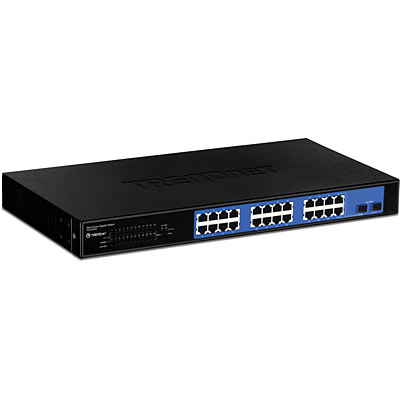What Equipment do we use?
Just like mentioned before, our equipment it broken down by our backbone and then our table switches. All of our switching equipment is Trendnet. Doing this makes support easier if you ever have problems and will cause fewer issues when hooking everything up. Networking is all about standards, but we have still found it to give us fewer issues when using only one brand over a mix and match of switches.

Our Backbone Switch
We currently only need one backbone switch and that includes running all of the staff and our servers on that same switch to give the best connectivity to game servers hosted on staff PC’s. For that we use the Trendnet TEG-240WS 24 Port Gigabit Web Smart Switch. Here are the Specifications
|
Standards |
IEEE 802.3 10Base-T |
|
Protocol |
CSMA/CD |
|
Transmission Method |
Store-and-Forward |
|
Interface |
24 x 10/100/1000Mbps Auto-MDIX RJ-45 ports |
|
Network Media |
Ethernet: UTP/STP Cat. 3, 4, 5 up to 100m |
|
Data Transfer Rate |
10Mbps: 10/20Mbps (Half/Full-Duplex) |
|
Data RAM Buffers |
512KBytes per device |
|
Filtering Address Table |
8K entries per device |
|
Switch Fabric |
48Gbps forwarding capacity |
|
Diagnostic LEDs |
Per Unit: Power, System |
|
Power Supply |
100 ~ 240VAC 50/60Hz, internal universal switching power |
|
Power Consumption |
35 watts (max) |
|
Dimension |
440 x 210 x 44mm (17.3 x 8.3 x 1.73in.) |
|
Weight |
3kg (6.6lb) |
|
Temperature |
Operating: 0°C ~ 40°C (32°F ~ 104°F) |
|
Humidity |
Operating: 10 % ~ 90 % (non-condensing) |
|
Certifications |
CE, FCC |
As you can see the TEG-240WS has all of the requirements that we set forth before. It has the added benefit of giving us mini-GBIC slots for fiber if we ever need to expand beyond one backbone switch. Going with a Web Smart switch gives us most of the benefits of a managed switch (all of the features we need), while being a little cheaper in price. Buying managed Gigabit switches is still VERY expensive, even when used.

Table Switches
Our table switches are a lot simpler than our Backbone and are considerably cheaper. We went Trendnet 24 Port Gigabit GREENnet Switches Model number TEG-S24Dg. These fulfill all of our requirements including size and even have a full 48Gbps forwarding capacity, something that isn’t a requirement on table switches. Here are the specifications.
|
Standards |
IEEE 802.3 10Base-T |
|
Network Media |
Ethernet: Cat. 5 up to 100 m Fast Ethernet: Cat. 5 and 5e up to 100 m Gigabit Ethernet: Cat. 5e and 6 up to 100 m |
|
Data Rate |
Ethernet: 10Mbps/20Mbps (half/full-duplex) Fast Ethernet: 100Mbps/200Mbps (half/full-duplex) Gigabit Ethernet: 2000Mbps (full-duplex) |
|
Protocol / Topology |
CSMA/CD, Star |
|
Power Consumption |
13 Watts (max.) |
|
Switch Fabric |
48Gbps |
|
Interface |
24 x 10/100/1000 Mbps Auto-MDIX RJ-45 ports |
|
Power Button |
On / off power button |
|
Data RAM Buffer |
3.5 MBits |
|
Filtering Table |
8 K entries |
|
Jumbo Frame Support |
Up to 9216Bytes |
|
Diagnostic LED |
Power, Link/ACT, 100Mbps, 1000Mbp |
|
Power |
100~240VAC, 50/60Hz Internal universal switching power |
|
Dimension |
280 x 180 x 44 mm (11 x 7 x 1.7 in.) |
|
Weight |
1.7 kg (3.8 lbs.) |
|
Temperature |
Operating: 0° ~ 40° C (32° ~ 104° F) Storage: -10° ~ 70° C (14° ~ 158° F) |
|
Humidity |
Max. 90% (non-condensing) |
|
Certifications |
CE, FCC |
I mentioned power usage earlier, the GREENnet Switches are designed to only use minimum voltage required meaning we will see the most efficient use of power as possible. The MAX power usage is a whopping 13 watts, when compared to the backbones 35 watts it’s even more impressive. That’s of course at maximum; depending on connection lengths and usage power consumption can be even less (70% less according to Trendnet). Another benefit we have found in the TEG-S24Dg that we didn’t realize when ordering was the built in power switch. This is great for resetting the network; you don’t even have to unplug the switch.
All in all we have been extremely happy with the network. We have been using the full Gigabit network using the Trendnet switches for a few events now and we haven’t had one network related issue. The internet is a whole different issue. We can cover how to cover internet at your event in another write-up. Best of luck with your event and feel free to comment if you have any questions. If this write-up is helpful for setting up your event, please post on the comments here and let us know! We would love to hear about the events that have been helped.

